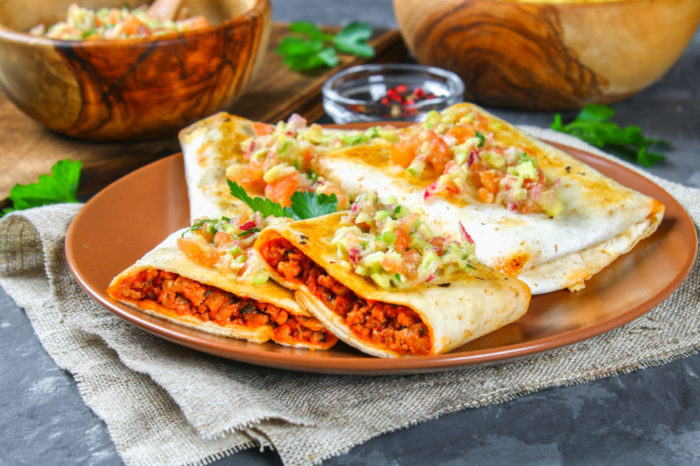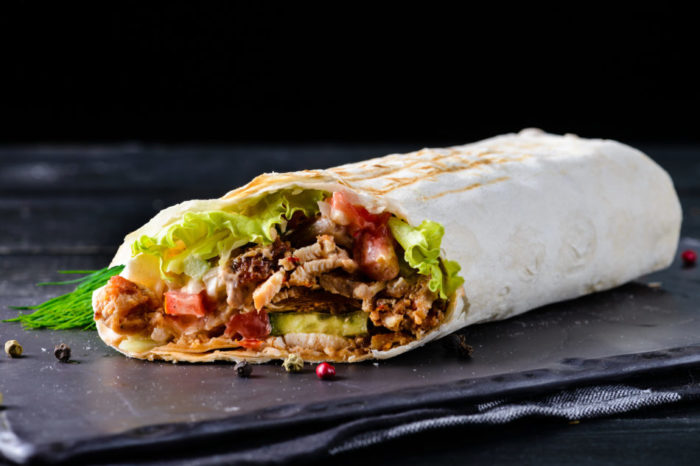They’re both highlights of Tex-Mex cuisine, but what’s the real lowdown on chimichanga vs burrito? They have very different names, but both these delicacies look suspiciously similar. And if we scratch the surface, we realize that they have a lot of similarities.
Given how similar they are, is there any difference beyond the name? Well, yes there is. While these are pretty identical in several aspects, they do show some very specific differences.
So, let’s get down to business and see what differentiates these two mouth-watering treats.


Difference Between Burrito And Chimichanga
Frying And Texture – The Big Part Of The Difference
So what’s the biggest difference between burritos and chimichanga? A chimichanga is always deep-fried while a burrito isn’t fried.
Though both these foods are wrapped in a tortilla, the deep frying changes the texture of chimichangas. The deep-fried tortilla is brown, crunchy, and crispy. This part alone sets chimichangas to be visibly different from burritos.
Ingredients – Is There A Difference Here?
In a sense, you could say that a chimichanga is a deep-fried burrito. And while you’re free to do exactly that, conventional recipes would beg to differ.
Burritos include a filling of beans, meat, rice, salsa, cheese, etc. You’ll find burritos often leaning towards beans and veggies. Chimichangas take a different approach. The preference of fillings here seems to shift towards meat. You’ll find an average chimichanga to be meatier than an average burrito.
Serving Styles Are Different For Both Foods
How these foods are served and eaten is generally different. Burritos tend to be more on the side of being a quick food. You can hold the burrito in your hands and directly take a bite off it. Often, burritos are wrapped and rolled in foil, making them easier to carry and eat.
Chimichangas are served on a plate. They’ll often get a covering (or coating) of sauces, cream, or other condiments and ingredients. Melted cheese is often a common topping. The presence of all these toppings means that you can’t eat a chimichanga with your hands or take a direct bite off the food.
Instead, you’ll rely on a fork and knife to eat this food. It’s a small, but significant difference.
Is There A Healthier Option?
Would you like to base your choice on which food is healthier? Taking a quick guess shouldn’t be difficult!
Deep-fried chimichangas are full of saturated and trans fats. Besides, the filling often doesn’t bode well for a balanced meal, even if the meat could be seen as healthy.
On the other hand, burritos are way healthier, especially in comparison to chimichangas. The lack of frying makes a big difference in the overall calorie count and the presence of fats in this food. Besides, the filling is better balanced and contains a good portion of beans, meat, and vegetables.
What Is A Burrito?
I would generally say that the burrito needs no introduction. However, it is important here to delve into the comparison with the chimichanga.
The origin story of the burrito starts in Northern Mexico. No one’s sure when, but it’s been a while. Initially, the burrito was a combination of beans and meat wrapped in a tortilla. Wrapping it in a tortilla gives the food a nice, clean, and cylindrical packaging.
This also makes it possible to eat a burrito directly by hand or by taking bites off it. As the burrito was introduced in the USA and got popular, it received a change in ingredients. More specifically, the fillings for the burrito underwent a change to better suit the American tastebuds.
It’s similar to pizza. The pizza we all know (and love) is different from the traditional Italian pizza. In the same vein, the burrito changed too.
Modern burritos usually have fillings that are a mix of several ingredients. These include (but aren’t necessarily limited to) beans, meat, vegetables, rice, salsa, cheese, etc. As we can all attest, it is indeed a mouth-watering combination.
Oh and there’s another little thing about the burrito. When translated to English, burrito literally means “little donkey”. It’s unclear how the dish got its name, but I believe we can all be thankful there are no actual little donkeys in our burrito!
What Is A Chimichanga?
Marketing and naming go a long way in establishing anything. Whoever named chimichangas must have had a stroke of genius. Well, it’s not the most elegant name out there, but it is unforgettable. Even someone who hasn’t ever had the opportunity to taste Tex-Mex cuisine would remember this name. And they would not hesitate to try it out!
The origins of chimichanga aren’t clear. Often, the dish is believed to have first been crafted in Southwestern US. It is somewhat believable, if we go on the stereotype of the love Texas has for deep-frying everything edible. Or perhaps deep-frying things until they become edible.
In any case, a chimichanga sees a filling covered in tortilla and then deep-fried. While you could use the same filling as a burrito here, modern chimichangas usually prefer a filling that’s richer in meat. You can expect the chimichanga to have a lot more meat than a burrito.
Of course, there’s no law that says that chimichangas need to overflow with meat. We’re talking of conventional recipes here. So, if you order a chimichanga in a restaurant, a meatier dish is what you’ll get.
Since chimichangas are deep-fried, they have that wonderfully brown exterior with a crispy and crunchy crust.
In discussing these delicacies, the key points to know in a burrito vs chimichanga comparison. Though they are very similar recipes, here’s what makes for a viable difference between burrito and chimichanga.
The Burrito Chimichanga Connection
Closely similar as they are, there are significant aspects that differentiate between burritos and chimichangas. As we see with this chimichanga vs burrito comparison, the biggest difference is frying. While both of these dishes could be nearly identical, the chimichanga is deep-fried.
With this small change, the recipes and even preparation take on different routes. As a result, you’ll find that the modern chimichanga is different from the burrito in several aspects, including appearance, filling, texture, and serving style.